|
Now
for some of my favorite pictures along the Li River. Unfortunately,
as you've seen throughout this whole album, the pictures aren't
spectacular mostly because of the weather. Can you imagine how beautiful
the shots could have been of the jagged limestone peaks in clear,
sunny weather or, better yet, with a sunset behind them? Looking
at these pictures almost makes you want to cry because you realize
how much better they could have been had the weather cooperated
and had you had more time and control over where you were and when
you were there. Perhaps a trip for another time.
|
|
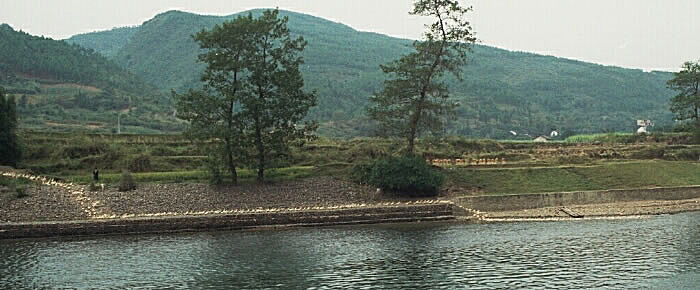 This
picture deserves explanation: Notice the light yellow line that
begins at the left center of the photo
This
picture deserves explanation: Notice the light yellow line that
begins at the left center of the photo
and continues down and across by the water's edge, then descends
into water and continues almost
to the edge of the picture. I know you can't make out what it is,
but it was a flock of ducks. Notice
the man standing on the left (to the right of the duck line in the
center). He was leading his ducks to the
water for a swim, a path they'd obviously followed many times before.
This was an amazing sight to
watch. The ducks, quacking away, came running (not walking) down
the path, along the top of the concrete
wall, down the steps and into the water. One continuous line, two
or three abreast, for as long as we
could see them. Anne got videos of it and they're great to watch.
What we found amazing is that not
one of the ducks took a shortcut to the water by jumping in from
the wall. They all followed the leader
down the steps and into the water. The man just stood there and
watched them pass. |
|
|
|
|
|
|
|
|
|
|
|
|
|
|
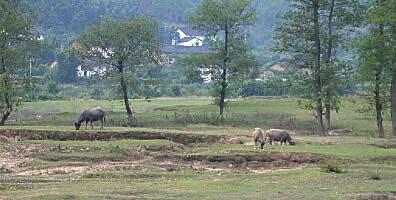 Water
buffalo grazing by the water's edge
Water
buffalo grazing by the water's edge |
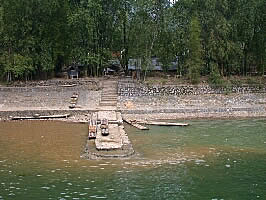 Small
dock with bamboo fishing rafts
Small
dock with bamboo fishing rafts |
|
|
|
|
|
|
|
|
|
|
|
|
|
|
 Herding
ducks by the river
Herding
ducks by the river |
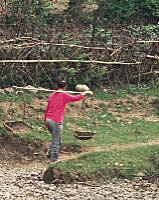 Shoulder
carrier
Shoulder
carrier |
 Single
water buffalo grazing
Single
water buffalo grazing |
|
| One
the highlights of any trip like this is to observe the native people
as they go about their daily routines. The Li River was an exceptional
place to do so. There was much people activity all along the river.
Farmers tilling land, duck herders watching over their flocks, people
washing laundry in the river, fishermen and much more. Another special
treat was seeing so many water buffalo. Our local guide told us that
the water buffalo lead charmed lives. I think he said they don't eat
them and only use them for farming chores, then he added they only
work ten days a year. I found that hard to believe, but they're useful
only in tilling the land and not after the crop is planted. |
|
|
|
|
|
|
|
|
|
|
|
|
|
|
|
|
|
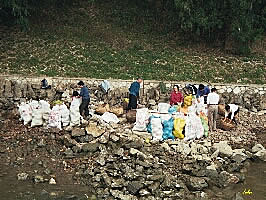 Supplies
offloaded from a boat and
Supplies
offloaded from a boat and
ready to be carried home |
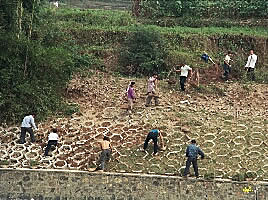 Workers
beautifying the riverside
Workers
beautifying the riverside
Photo by John |
Outside
of the cities we visited there was never any evidence of machinery
being used. There were no tractors on the farms, no bulldozers working
on roads, and no heavy machinery at the coal processing plants. There
was one exception. I saw a heavy earth mover along the Li River. |
|
|
|
|
|
|
|
|
|
|
|
|
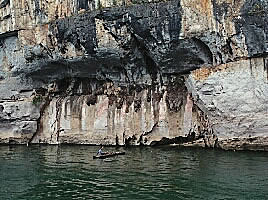 Fishing
near a rock face
Fishing
near a rock face |
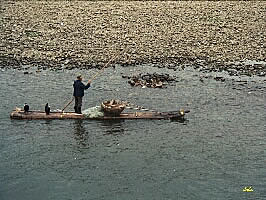 Cormorant
fisherman
Cormorant
fisherman
Photo by John |
|
|
|
|
|
|
|
|
|
|
|
|
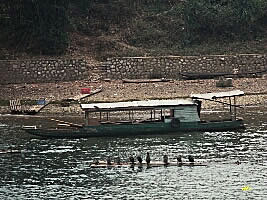 Cormorants
waiting for their master
Cormorants
waiting for their master
to go fishing (Photo by John) |
About
the Cormorant fishermen:
Cormorants are good sized birds who, like the Anhingas found in the
Everglades, enjoy diving underwater in search of fish. The Chinese
have taken this a step further and conscripted them into service as
their hook, line and sinker. They use the Cormorants to catch the
fish and return them to the boat. In the picture above you see a typical
Cormorant fisherman. He rides on a small bamboo raft barely 3 feet
wide and pushes himself along the river using a bamboo pole. He also
uses the pole to chase the birds into the water where they dive below
the surface in search of fish. When they catch a fish they return
to the boat and the fisherman removes the fish from their throat and
places it in the basket. Why doesn't the Cormorant just eat the fish?
They can't. The fisherman places a cord around the bird's neck to
constrict it and keep the bird from swallowing the fish. We did a
night excursion in Guilin to watch them fish and it was fascinating
(pictures on next page). |
|
|
|
|
|
|
|
|
|
|
|
|
| With
our excursion down the Li River now at an end the boat docked and
we proceeded through the maze of "dollar people" and shops
to our awaiting bus ... but not before I had a chance to take a couple
of pictures. |
|
|
|
|
|
|
|
|
|
|
|
|
|
|
|
|
Two
fisherman with their Cormorants (Photo right by John, yes, John
it's the better photo!)
|
|
|
|
|
|
|
|
|
|
|
|
|
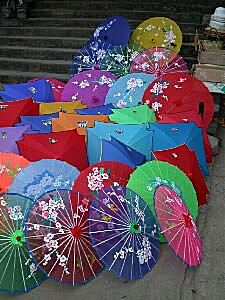 Umbrellas
for sale
Umbrellas
for sale |
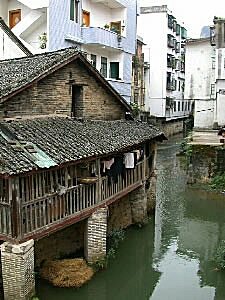 Backs
of homes along a canal
Backs
of homes along a canal |
 School
children
School
children |
|
|
|
|
|
|
|
|
|
|
|
|
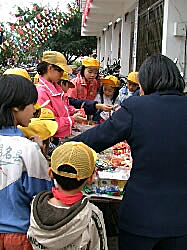 School
children buying toys
School
children buying toys |
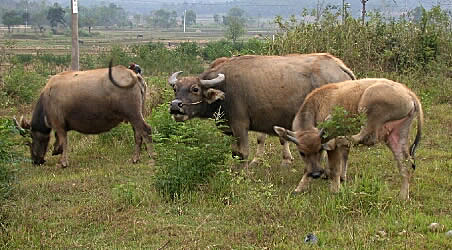 Water
buffalo, up close and personal ... finally
Water
buffalo, up close and personal ... finally |
|
|
|
|
|
|
|
|
|
|
|
|
Don't
ask me why, but I've always wanted to get what I call that perfect
shot of a water buffalo working in a field. The image is as clear
in my mind as it can be without being on paper. It's something
I've wanted ever since the first time Anne and I visited China
(when they wouldn't let me off the bus to take the picture) back
in 1984. Along the Li River we saw many water buffalo, loads of
them, so I asked Mei, the tour escort, to ask the driver to stop
along the road if he saw any water buffalo so I could take a few
shots. Everyone who overheard my request was laughing and commenting
on my request. Of course I hoped they'd be working in the fields.
When the driver saw a group of water buffalo in a field next to
the road he quickly stopped and I went outside to take some pictures.
Oh, those that laughed followed me to take pictures also. Unfortunately
they weren't as I had hoped, working a field, they were just standing
there, but I was still happy.
Oh,
one last thing before we go to the next page. There was an old
man on the side of the road grazing two cows by the field where
we took the pictures. Some took pictures of him with the cows,
but I didn't want pictures of cows, I wanted water buffalo so
I went into the field and took the above shot. After I took the
shot I went over by the old man and the cows, and then it was
time to get back on the bus. Just before we left several of us
reached into our pockets and gave the old man a few RMB. He was
really smiling and I can envision that he might have thought us
nuts. I mean he standing on the side of the road minding his own
business when this busload of tourist comes along, jumps out,
takes a few pictures and then gives him money. He probably made
that location a camp for the next few days hoping more tourist
would do the same or, maybe, they'd done so before and he was
still reaping the benefits.
Now,
let's go to the last page of pictures from Guilin ...
|

